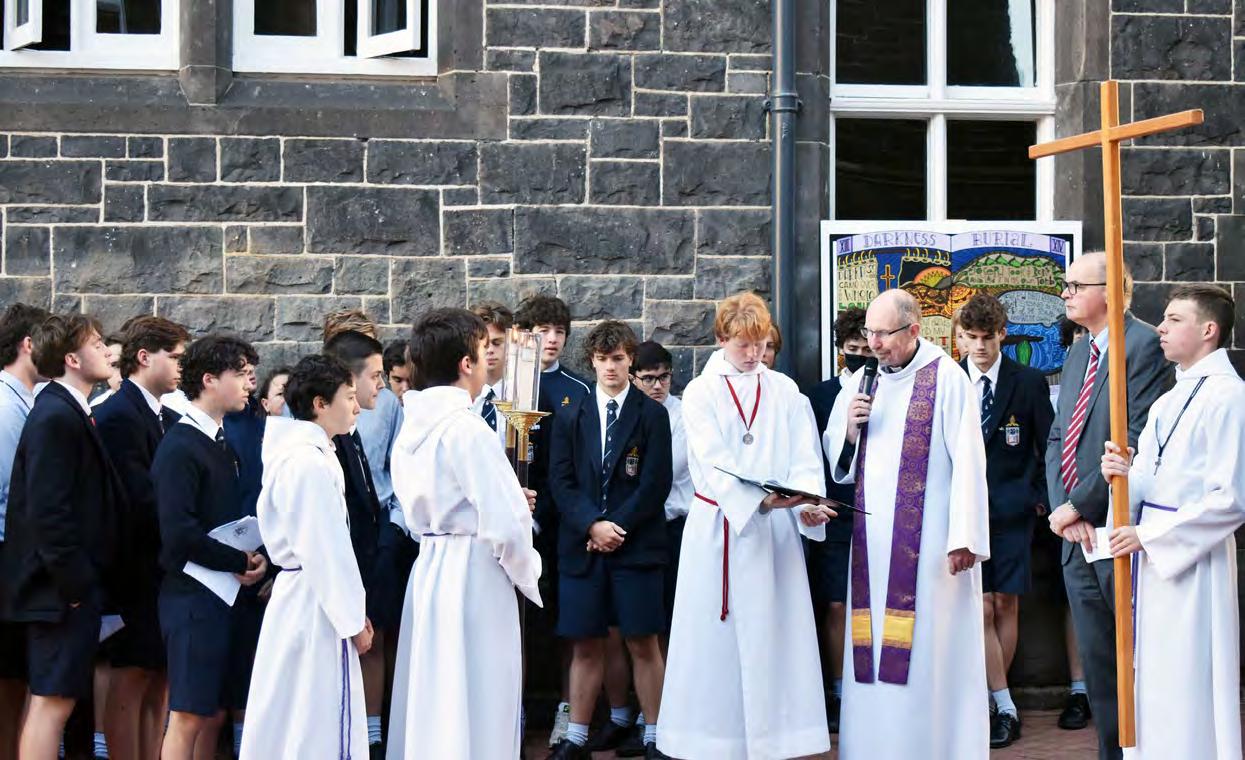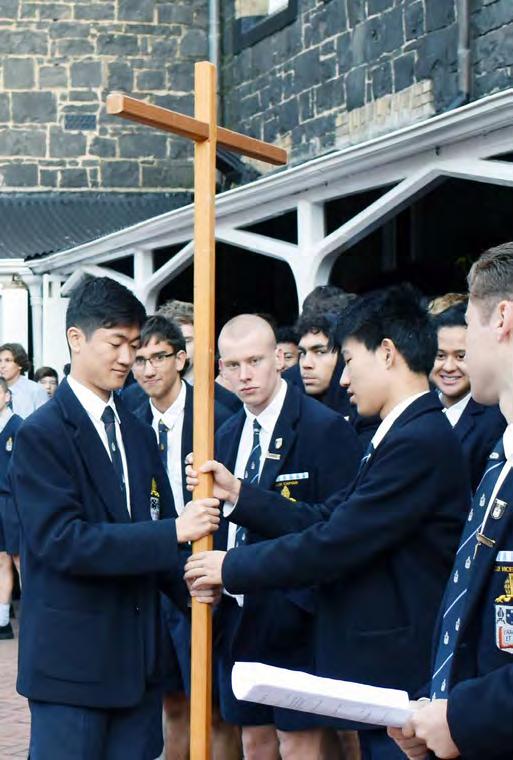
5 minute read
Made to Worship
The Reverend Dr J Hugh Kempster, Acting Senior Chaplain | Melbourne Grammar School, VIC Thou awakest us to delight in Thy praise; for Thou madest us for Thyself, and our heart is restless, until it repose in Thee. Saint Augustine, Confessions, Book I
In the opening to his Confessions, Saint Augustine makes an almost credal statement. To paraphrase: we are made to worship God, and we are not at peace as human beings until we awaken to this truth. Education, therefore, is arguably replete without the experience of worship at its core. Anglican educators have long built on this sure foundation, materially evident, in our older schools at least, by the Chapel at the heart of the school. The two Victorian schools in which I have had the privilege of serving as Chaplain, Geelong Grammar and Melbourne Grammar, likewise reflect this precept in their mottos: Christus nobis factus sapientia ‘For us, Christ was made Wisdom’; and Ora et labora ‘Prayer and Work’. Moving between parish ministry and school chaplaincy over the years, one of the first things that strikes me with each transition is the question of volition. Parishioners choose to come to worship, but chapel services in most, if not all Anglican schools, are obligatory for students. In Augustinian terms, we may well be made to worship God, but should (or can) our students be made to worship God? Like all chaplains, I am sure, I can recall a legion of decidedly restless adolescents squirming in the chapel pews, clearly longing for the words of dismissal and final release into recess, or at least the next class. Is this really worship, or closer to torture for all involved? An epigraph to Evelyn Underhill’s twentieth-century classic Worship perhaps gives us a leg to stand on: All worship was to him sacred, since he believed that in its most degraded forms, among the most ignorant and foolish of worshippers, there has yet been some true seeking after the Divine, and that between these and the most glorious ritual or the highest philosophic certainty, there lies so small a space that we may believe the Saints in Paradise regard it with a smile.
Elizabeth Waterhouse: Thoughts of a Tertiary
Far be it from me to categorise any of our beloved students as degraded, ignorant, or foolish, but there is such erudite optimism in the words of these two wise women from last century. Worship is worship is worship. The depth of our engagement, or lack of it, cannot ultimately sully the divine act. Even the most wriggling hymn-book-snapping adherent is guaranteed to raise a loving smile from the heavens. I like that.

One might also turn to the evidence of the statisticians and researchers for respite on those disheartening days of chapel distraction. The ‘Spirit of Generation Y’ project (Mason, et al., 2007) was a three-year study (2003–2006) of the spirituality of young Australians. One of the questions asked was simply: “Do you believe in God?” Remarkably, eight out of ten students answered either “yes” (48%) or “unsure” (32%) with only two in ten (19%) identifying as atheists. More recently McCrindle Research, on behalf of the Centre for Public Christianity, asked a thousand people about their openness to the existence of a range of spiritual realities: ghosts, miracles, angels, a higher power/God, the soul, ultimate meaning or purpose in life, and life after death. Notably, it was the youngest age group (18 to 26-year-olds) who showed the most openness: 61% either believed in God or were open to the possibility; 21% were agnostic, unsure if God exists; and only 18% either believed that God does not exist or thought it unlikely. In Natasha Moore’s ABC News article on this research, she quotes poet Les Murray, who as ever says it all: “I just speak as I am. I am a Catholic and I don’t believe that other people are necessarily secular. I think that intellectuals are mostly secular or are required to pretend that they are. But broader people are very varied.” We chaplains may be swayed on bad days by the ‘intellectuals’ and believe that no one is listening as we preach to our deadpan captive congregations. But on a good day, I’m not so sure. Finally, an anecdote from my current school experience, just prior to Holy Week this year. In a moment of naïve exuberance someone (me) came up with the idea that we might try a whole-of-school outdoors ‘Stations of the Cross’ meditation at the end of Term 1. As the day approached my esteemed colleagues started wondering (as did I in the early hours of the morning) whether this was such a clever idea after all. The day arrived, and the entire Senior School gathered in the Quad. ‘Restless’ was a fitting descriptor for the mood of the students as we gathered for this new worship service.
The First Station – Sorrow “I am deeply grieved, even to death … my God, if it is possible let this cup pass from me” (Matthew 26:389). Jesus prays with the disciples in the Garden of Gethsemene. He is human. He does not want to walk the way of pain and suffering that lies before him. We pray for all who suffer; all victims of war, violence and abuse. Station by station the restlessness eased, and remarkably, overwhelmingly even, hundreds of teenagers and their teachers engaged in a solemn act of communal meditation. Our hearts found rest: believers, agnostics, atheists, Hindus, Buddhists, Muslims. We worshipped together. It was a cold morning, and some were even shaking a little as we reflected together on the unjust execution of truly good man; the Son of God as we Christians call him.
The Fourteenth Station – Burial “Joseph took the body and laid it in his own tomb. Joseph then rolled a great stone to the door of the tomb and went away” (Matthew 27:59-60). Jesus is hastily wrapped in cloth and sealed up, a lifeless corpse, in a rich man’s tomb. The living Word of God lies silent in the sleep of death; heaven and earth are silent around him, waiting … You could quite literally have heard a pin drop as the Headmaster said these final words, and we stood as one for a few moments of contemplative silence, before heading off to the first period. Are we made to worship God? Yes. Should our students be made to worship as part of their education in an Anglican school? I think so.
References:
Mason, Michael; Singleton, Andrew; and Webber, Ruth. “The Spirituality of Young Australians.” International Journal of Children’s Spirituality, vol. 12, no. 2. August 2007, pp. 149–163. Moore, Natasha. “We asked Australians if they believe in God or the supernatural. Here’s what they said.” ABC News, 4th April 2021. Accessed 7th May 2022 https://www.abc.net.au/news/2021-04-04/spiritualsupernatural-realities-australians-weig-in-thiseaster/100046122 Pusey, Edward Bouverie, trans. The Confessions of Saint Augustine. Project Gutenberg, 1838/2002. Accessed 7th May 2022 https://www.gutenberg.org/files/3296/3296-h/3296-h. htm#link2H_4_0001> Underhill, Evelyn. Worship. London: Nisbet, 1936.









